

Compact Muon Solenoid
LHC, CERN
| CMS-PAS-B2G-16-005 | ||
| Search for electroweak production of a vectorlike quark decaying to a top quark and a Higgs boson using boosted topologies in an all-hadronic final state | ||
| CMS Collaboration | ||
| June 2016 | ||
| Abstract: A search is performed for the electroweak production of a vectorlike top quark partner T of charge +2/3 in association with a standard model top or bottom quark, using 2.3 fb−1 of proton-proton collision data at √s= 13 TeV collected by the CMS experiment. The search targets T quarks decaying to a top quark and a Higgs boson in a fully hadronic final state. For a T quark with mass above 1 TeV, the daughter top quark and the Higgs boson are highly Lorentz-boosted and each can be reconstructed as a single hadronic jet. Jet substructure and b tagging techniques are used to identify the top quark and Higgs boson jets, and to suppress the standard model backgrounds, which are found to be consistent with observations. Upper limits at 95% CL are set on the product of the single T quark production cross section and the B(T→tH) that vary between 0.31-0.93 pb for T quark masses in the range 1000-1800 GeV. | ||
|
Links:
CDS record (PDF) ;
inSPIRE record ;
CADI line (restricted) ;
These preliminary results are superseded in this paper, JHEP 04 (2017) 136. The superseded preliminary plots can be found here. |
||
| Figures | |
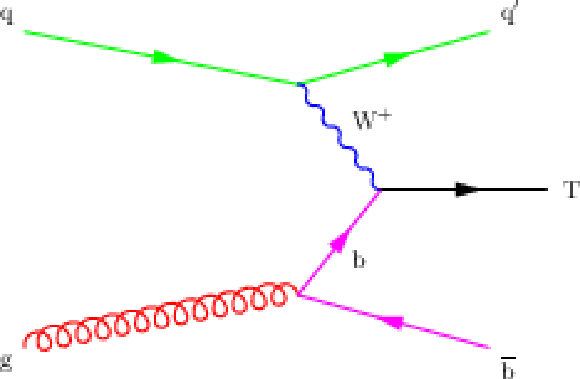
png pdf |
Figure 1-a:
Production diagrams for the processes pp→Tbq with the charged current (a) and pp→Ttq with the neutral current (b). |

png pdf |
Figure 1-b:
Production diagrams for the processes pp→Tbq with the charged current (a) and pp→Ttq with the neutral current (b). |
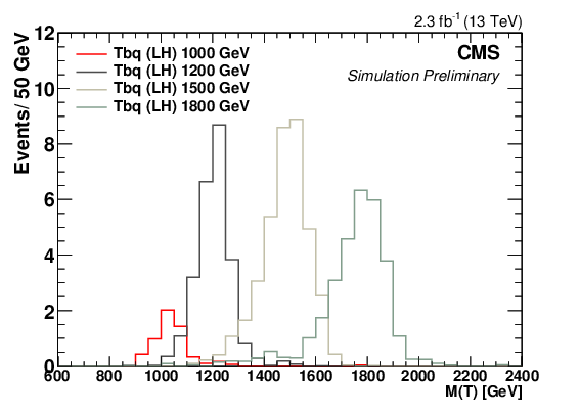
png pdf |
Figure 2:
The M(T) distributions for the pp→Tbq production mode with LH coupling for the T quark masses 1000, 1200, 1500, and 1800 GeV after all the selection criteria. The signal σB(T→tH) is set to 1 pb. |
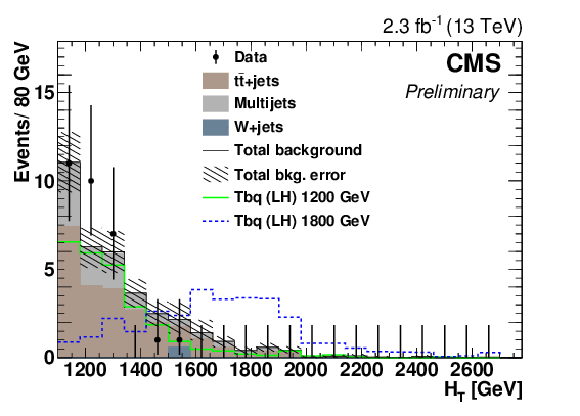
png pdf |
Figure 3-a:
The HT (a) and M(T) (b) distributions after full event selection. The black markers with error bars are the data. The various background components are shown as filled histograms, and are estimated using simulations (t¯t+jets and W+jets ) and the data (non-t¯t+jets and non-W+jets multijets component). The T quark signal distribution for two T quark masses are also shown. The signal σB(T→tH) is set to 1 pb. |
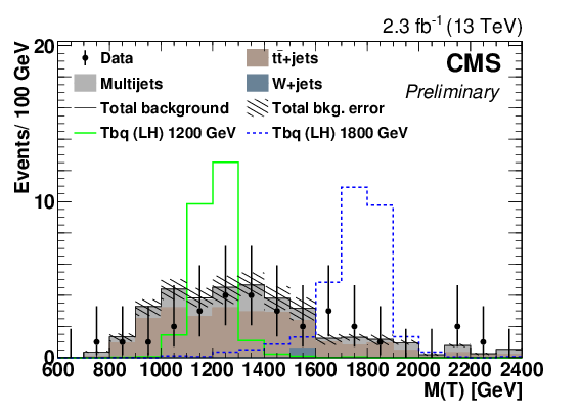
png pdf |
Figure 3-b:
The HT (a) and M(T) (b) distributions after full event selection. The black markers with error bars are the data. The various background components are shown as filled histograms, and are estimated using simulations (t¯t+jets and W+jets ) and the data (non-t¯t+jets and non-W+jets multijets component). The T quark signal distribution for two T quark masses are also shown. The signal σB(T→tH) is set to 1 pb. |
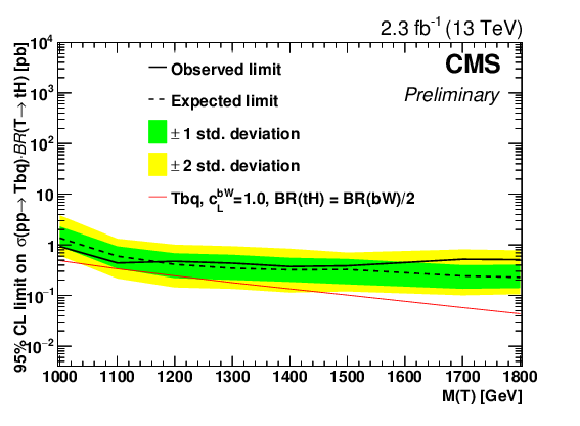
png pdf |
Figure 4-a:
The expected and observed limits on the σB(T→tH) of the production processes pp→Tbq (a,b) and pp→Ttq (c,d), for different assumed values of the T quark mass, and with left handed (a,c) and right-handed (b,d) coupling to the SM 3rd generation quarks. The theoretical lines in the top left and bottom right figures correspond to those predicted by the Simplest Simplified Model of Ref. [21,22], which predict the existence of a left and right handed coupling for a singlet and doublet T quark, respectively. No theoretical prediction of a right handed singlet or a left handed doublet is possible within the simplified model, and thus theoretical cross sections are not shown for the top right and the bottom left plots. It should however be noted that such couplings may still be possible in a non-minimal model. |

png pdf |
Figure 4-b:
The expected and observed limits on the σB(T→tH) of the production processes pp→Tbq (a,b) and pp→Ttq (c,d), for different assumed values of the T quark mass, and with left handed (a,c) and right-handed (b,d) coupling to the SM 3rd generation quarks. The theoretical lines in the top left and bottom right figures correspond to those predicted by the Simplest Simplified Model of Ref. [21,22], which predict the existence of a left and right handed coupling for a singlet and doublet T quark, respectively. No theoretical prediction of a right handed singlet or a left handed doublet is possible within the simplified model, and thus theoretical cross sections are not shown for the top right and the bottom left plots. It should however be noted that such couplings may still be possible in a non-minimal model. |

png pdf |
Figure 4-c:
The expected and observed limits on the σB(T→tH) of the production processes pp→Tbq (a,b) and pp→Ttq (c,d), for different assumed values of the T quark mass, and with left handed (a,c) and right-handed (b,d) coupling to the SM 3rd generation quarks. The theoretical lines in the top left and bottom right figures correspond to those predicted by the Simplest Simplified Model of Ref. [21,22], which predict the existence of a left and right handed coupling for a singlet and doublet T quark, respectively. No theoretical prediction of a right handed singlet or a left handed doublet is possible within the simplified model, and thus theoretical cross sections are not shown for the top right and the bottom left plots. It should however be noted that such couplings may still be possible in a non-minimal model. |

png pdf |
Figure 4-d:
The expected and observed limits on the σB(T→tH) of the production processes pp→Tbq (a,b) and pp→Ttq (c,d), for different assumed values of the T quark mass, and with left handed (a,c) and right-handed (b,d) coupling to the SM 3rd generation quarks. The theoretical lines in the top left and bottom right figures correspond to those predicted by the Simplest Simplified Model of Ref. [21,22], which predict the existence of a left and right handed coupling for a singlet and doublet T quark, respectively. No theoretical prediction of a right handed singlet or a left handed doublet is possible within the simplified model, and thus theoretical cross sections are not shown for the top right and the bottom left plots. It should however be noted that such couplings may still be possible in a non-minimal model. |

png pdf |
Figure 5-a:
The expected and observed limits on the scaling factors |cbWL| (a) and |ctZR| (b) of the Simplest Simplified Model of Ref. [21,22], wh ich predict the existence of a left and right handed coupling for a singlet and double Tquark, respectively. The left (a) plots are for a singlet (doublet) T quark. |
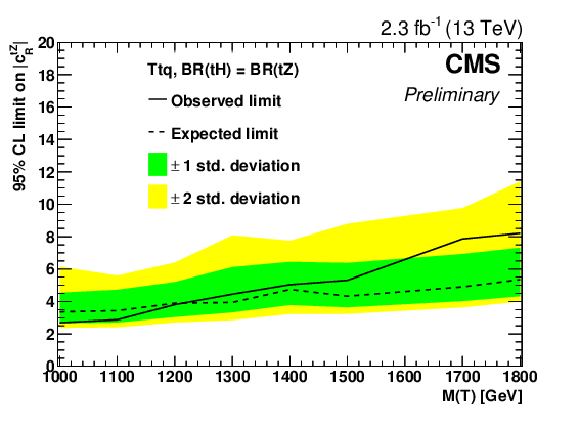
png pdf |
Figure 5-b:
The expected and observed limits on the scaling factors |cbWL| (a) and |ctZR| (b) of the Simplest Simplified Model of Ref. [21,22], wh ich predict the existence of a left and right handed coupling for a singlet and double Tquark, respectively. The left (a) plots are for a singlet (doublet) T quark. |
| Tables | |

png pdf |
Table 1:
The signal efficiencies for successive event selections in percent for the pp→Tbq (LH) and pp→Ttq (LH) models. The statistical size of the simulated signal samples are much larger than the total integrated luminosity and hence the statistical errors on the efficiencies are negligible. |

png pdf |
Table 2:
Numbers of events for the control region A, B,and C in the data, and the non-multijets background. The difference between the data and the t¯t+jets , W+jets , and the tW, is attributed to the multijets background component. The errors are statistical only. |
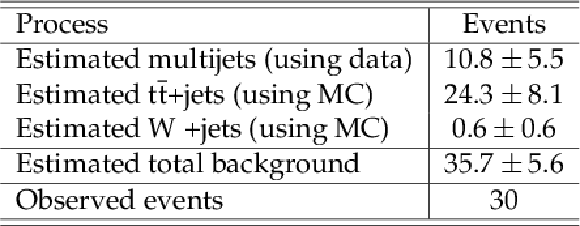
png pdf |
Table 3:
Estimated background and observed events in the signal region after all selection criteria. The combined statistical and systematic uncertainty is shown. The systematic uncertainty on the data-driven multijets background is anticorrelated with that on the MC-driven t¯t+jets background. Hence the uncertainty on the total background is less than what one would obtain if the uncertainties on the individual backgrounds are added in quadrature. |

png pdf |
Table 4:
The observed and expected 95% CL upper limits on the cross sections times the branching ratio σ(pp→Tbq)B(T→tH) and σ(pp→Ttq)B(T→tH), for different masses of the T quark. |
| Summary |
| A search for a vectorlike top quark partner T in the single production mode is performed using pp collision events at √s= 13 TeV collected by the CMS experiment in 2015. The T quarks are assumed to couple only to the SM 3rd generation quarks. The decay channel exploited is T→tH, with hadronic top quark decay, and H→bb. Boosted H and t tagging are used to identify the top quark and Higgs boson decays in the final state, and the invariant mass of the two gives the T quark candidate mass. The background is mostly due to SM tˉt+jets, with some amount of multijet and W+jets processes. No excess of data above the background is observed and 95% CL upper limits on σB(T→tH) are set varying between 0.31-0.93 pb for T quark masses ranging from 1000 GeV to 1800 GeV in the T→bq and T→tq production channels with left and right handed couplings to the SM third generation quarks. |
| References | ||||
| 1 | M. Schmaltz and D. Tucker-Smith | Little Higgs review | Ann. Rev. Nucl. Part. Sci. 55 (2005) 229 | hep-ph/0502182 |
| 2 | M. Perelstein, M. E. Peskin, and A. Pierce | Top quarks and electroweak symmetry breaking in little Higgs models | PRD 69 (2004) 075002 | hep-ph/0310039 |
| 3 | I. Antoniadis, K. Benakli, and M. Quiros | Finite Higgs mass without supersymmetry | New J. Phys. 3 (2001) 20 | hep-th/0108005 |
| 4 | Y. Hosotani, S. Noda, and K. Takenaga | Dynamical gauge-Higgs unification in the electroweak theory | PLB 607 (2005) 276 | hep-ph/0410193 |
| 5 | K. Agashe, R. Contino, and A. Pomarol | The Minimal composite Higgs model | Nucl. Phys. B 719 (2005) 165 | hep-ph/0412089 |
| 6 | R. Contino, L. Da Rold, and A. Pomarol | Light custodians in natural composite Higgs models | PRD 75 (2007) 055014 | hep-ph/0612048 |
| 7 | P. H. Frampton, P. Q. Hung, and M. Sher | Quarks and leptons beyond the third generation | PR 330 (2000) 263 | hep-ph/9903387 |
| 8 | A. De Simone, O. Matsedonskyi, R. Rattazzi, and A. Wulzer | A First Top Partner Hunter's Guide | JHEP 04 (2013) 004 | 1211.5663 |
| 9 | J. A. Aguilar-Saavedra, R. Benbrik, S. Heinemeyer, and M. Pérez-Victoria | Handbook of vectorlike quarks: Mixing and single production | PRD 88 (2013) 094010 | 1306.0572 |
| 10 | Y. Okada and L. Panizzi | LHC signatures of vector-like quarks | Adv. High Energy Phys. 2013 (2013) 364936 | 1207.5607 |
| 11 | ATLAS, CMS Collaboration | Combined Measurement of the Higgs Boson Mass in pp Collisions at √s=7 and 8 TeV with the ATLAS and CMS Experiments | PRL 114 (2015) 191803 | 1503.07589 |
| 12 | ATLAS Collaboration | Observation of a new particle in the search for the Standard Model Higgs boson with the ATLAS detector at the LHC | PLB 716 (2012) 1 | 1207.7214 |
| 13 | CMS Collaboration | Observation of a new boson at a mass of 125 GeV with the CMS experiment at the LHC | PLB 716 (2012) 301 | CMS-HIG-12-028 1207.7235 |
| 14 | CMS Collaboration | Search for vector-like charge 2/3 T quarks in proton-proton collisions at sqrt(s) = 8 TeV | PRD 93 (2016) 012003 | CMS-B2G-13-005 1509.04177 |
| 15 | ATLAS Collaboration | Search for production of vector-like quark pairs and of four top quarks in the lepton-plus-jets final state in pp collisions at √s=8 TeV with the ATLAS detector | JHEP 08 (2015) 105 | 1505.04306 |
| 16 | ATLAS Collaboration | Search for single production of vector-like quarks decaying into Wb in pp collisions at √s= 8 TeV with the ATLAS detector | Submitted to EPJC | 1602.05606 |
| 17 | ATLAS Collaboration | Search for production of vector-like top quark pairs and of four top quarks in the lepton-plus-jets final state in pp collisions at √s=13 TeV with the ATLAS detector | ATLAS Conference Note ATLAS-CONF-2016-013, CERN | |
| 18 | CMS Collaboration | Search for pair production of vector-like T quarks in the lepton plus jets final state | CMS-PAS-B2G-16-002 | CMS-PAS-B2G-16-002 |
| 19 | CMS Collaboration | Search for Single Production of a Vector Like T Quark Decaying to a Higgs Boson and a Leptonically Decaying Top Quark | CMS-PAS-B2G-15-008 | CMS-PAS-B2G-15-008 |
| 20 | B. Mellado Garcia, P. Musella, M. Grazzini, and R. Harlander | CERN Report 4: Part I Standard Model Predictions | CERN Report LHCHXSWG-DRAFT-INT-2016-008, CERN | |
| 21 | O. Matsedonskyi, G. Panico, and A. Wulzer | On the Interpretation of Top Partners Searches | JHEP 12 (2014) 097 | 1409.0100 |
| 22 | J. M. Campbell, R. K. Ellis, and F. Tramontano | Single top production and decay at next-to-leading order | PRD 70 (2004) 094012 | hep-ph/0408158 |
| 23 | J. Alwall et al. | The automated computation of tree-level and next-to-leading order differential cross sections, and their matching to parton shower simulations | JHEP 07 (2014) 079 | 1405.0301 |
| 24 | R. D. Ball et al. | Parton distributions for the LHC Run II | JHEP 2015 (04) 40 | 1410.8849 |
| 25 | P. Nason | A New method for combining NLO QCD with shower Monte Carlo algorithms | JHEP 11 (2004) 040 | hep-ph/0409146 |
| 26 | S. Frixione, P. Nason, and C. Oleari | Matching NLO QCD computations with Parton Shower simulations: the POWHEG method | JHEP 11 (2007) 070 | 0709.2092 |
| 27 | S. Alioli, P. Nason, C. Oleari, and E. Re | A general framework for implementing NLO calculations in shower Monte Carlo programs: the POWHEG BOX | JHEP 06 (2010) 043 | 1002.2581 |
| 28 | S. Frixione, G. Ridolfi, and P. Nason | A positive-weight next-to-leading-order Monte Carlo for heavy flavour hadroproduction | JHEP 2007 (2007) 126 | 0707.3088 |
| 29 | T. Sjostrand, S. Mrenna, and P. Z. Skands | A Brief Introduction to PYTHIA 8.1 | CPC 178 (2008) 852 | 0710.3820 |
| 30 | M. Czakon and A. Mitov | Top++: A Program for the Calculation of the Top-Pair Cross-Section at Hadron Colliders | CPC 185 (2014) 2930 | 1112.5675 |
| 31 | R. Gavin, Y. Li, F. Petriello, and S. Quackenbush | FEWZ 2.0: A code for hadronic Z production at next-to-next-to-leading order | CPC 182 (2011) 2388 | 1011.3540 |
| 32 | N. Kidonakis | Two-loop soft anomalous dimensions for single top quark associated production with a W− or H− | PRD 82 (2010) 054018 | 1005.4451 |
| 33 | N. Kidonakis | Top Quark Production | in Proceedings, Helmholtz International Summer School on Physics of Heavy Quarks and Hadrons (HQ 2013) | 1311.0283 |
| 34 | M. L. Mangano, M. Moretti, F. Piccinini, and M. Treccani | Matching matrix elements and shower evolution for top-quark production in hadronic collisions | JHEP 01 (2007) 013 | hep-ph/0611129 |
| 35 | CMS Collaboration | The CMS experiment at the CERN LHC | JINST 3 (2008) S08004 | CMS-00-001 |
| 36 | CMS Collaboration | Particle-Flow Event Reconstruction in CMS and Performance for Jets, Taus, and EmissT | ||
| 37 | M. Cacciari, G. P. Salam, and G. Soyez | The anti-kt jet clustering algorithm | JHEP 04 (2008) 063 | 0802.1189 |
| 38 | M. Cacciari and G. P. Salam | Dispelling the N3 myth for the kt jet-finder | PLB 641 (2006) 57 | hep-ph/0512210 |
| 39 | M. Cacciari, G. P. Salam, and G. Soyez | FastJet User Manual | EPJC 72 (2012) 1896 | 1111.6097 |
| 40 | M. Cacciari and G. P. Salam | Pileup subtraction using jet areas | PLB 659 (2008) 119 | 0707.1378 |
| 41 | CMS Collaboration | Determination of Jet Energy Calibration and Transverse Momentum Resolution in CMS | JINST 6 (2011) P11002 | CMS-JME-10-011 1107.4277 |
| 42 | CMS Collaboration | Jet Performance in pp Collisions at √s=7 TeV | CDS | |
| 43 | G. P. Salam | Towards Jetography | EPJC 67 (2010) 637 | 0906.1833 |
| 44 | S. D. Ellis, C. K. Vermilion, and J. R. Walsh | Recombination Algorithms and Jet Substructure: Pruning as a Tool for Heavy Particle Searches | PRD 81 (2010) 094023 | 0912.0033 |
| 45 | A. J. Larkoski, S. Marzani, G. Soyez, and J. Thaler | Soft Drop | JHEP 1405 (2014) 146 | 1402.2657 |
| 46 | CMS Collaboration | Identification techniques for highly boosted W bosons that decay into hadrons | JHEP 12 (2014) 017 | CMS-JME-13-006 1410.4227 |
| 47 | CMS Collaboration | Boosted Top Jet Tagging at CMS | CMS-PAS-JME-13-007 | CMS-PAS-JME-13-007 |
| 48 | J. Thaler and K. Van Tilburg | Identifying Boosted Objects with N-subjettiness | JHEP 03 (2011) 015 | 1011.2268 |
| 49 | CMS Collaboration | Identification of b-quark jets with the CMS experiment | JINST 8 (2013) P04013 | CMS-BTV-12-001 1211.4462 |
| 50 | CMS Collaboration | Identification of b quark jets at the CMS Experiment in the LHC Run 2 | CMS-PAS-BTV-15-001 | CMS-PAS-BTV-15-001 |
| 51 | CMS Collaboration | Top Tagging with New Approaches | CDS | |
| 52 | CMS Collaboration | CMS Luminosity Measurement for the 2015 Data Taking Period | CMS-PAS-LUM-15-001 | CMS-PAS-LUM-15-001 |
| 53 | J. Butterworth et al. | PDF4LHC recommendations for LHC Run II | JPG43 (2016) 023001 | 1510.03865 |
| 54 | The ATLAS and the CMS Collaborations, and the LHC Higgs Combination Group | Procedure for the LHC Higgs boson search combination in Summer 2011 | CMS-NOTE-2011-005 | |

|
Compact Muon Solenoid LHC, CERN |

|

|

|

|

|

|